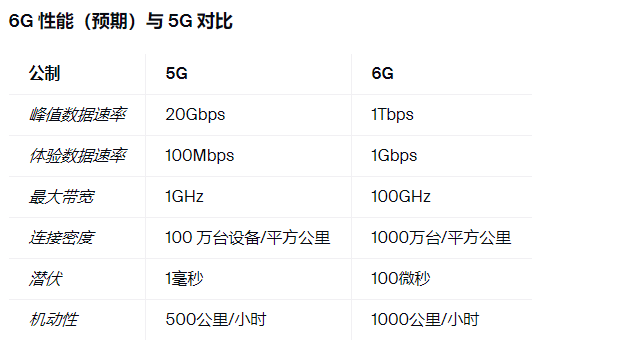What is the state of 6G now, and when will it come?

What is the state of 6G now, and when will it come?
6G will bring many advances in many ways, but the benefits will not be obvious yet.
Although 5G connectivity is far from widespread, planning and research for next-generation 6G is already underway in developed regions of the world.
Each generation of mobile networks consolidates the use cases provided by the previous generation and introduces new features, with a cycle of approximately 10 years. So 2G (1990) introduced digital voice calling and text messaging (SMS), 3G (2000) web added mobile browsing to smartphones, and 4G (2010) brought faster data transfer speeds, enabling Mobile video, while 5G (2020) brings faster, lower-latency mobile broadband, enabling use cases such as Industrial Internet of Things (IIoT), digital twinous, autonomous vehicles, smart homes, construction, cities and agriculture, and telemedicine.
What is 6G?
6G is the next generation of mobile networks after 5G, and more specifically, after the cornerstone of 5G Advanced based on the 3GPP Release 18 standard. Release 18 is expected to be finalized by mid-2024, with device and network support for 5G Advanced likely to roll out in 2025.
"5G Advanced will include major enhancements in the areas of artificial intelligence and extended reality (XR), which will enable highly intelligent network solutions to support a wider range of use cases than ever before," said 5G Americas.
What about 6G? Nokia said: "Literally every improvement in network connectivity that 5G brings to the end user will be further improved in 6G. Whether it is smart cities, agriculture or factories, or robots, 6G will be takes it all to the next level."
When will 6G arrive?
If the development of 6G proceeds at the historical 10-year pace, it is expected to see the first commercial network around 2030—perhaps in regions of the world where 5G networks were deployed earlier, such as Asia.
At the upcoming Mobile World Congress 2023, an annual opportunity to gauge the temperature of the mobile world, a key theme will be "5G Acceleration". Still, 6G has already made its presence felt in sessions titled "Ready to Talk 6G?" and "Spectrum: Enabling the 6G Future."
Expect to hear as requirements and standards are formulated, frequency bands (up to the terahertz level) are defined and allocated, radio access networks (RAN) are built, AI core networks are deployed, and 6G-enabled devices are brought to market. More on 6G here.
How fast will 6G be, and what use cases will it support?
According to the definition required by ITU IMT-2020, the peak theoretical data rate of 5G can reach up to 20Gbps downlink and 10Gbps uplink, the "user experience" rate can reach up to 100Mbps downlink and 50Mbps uplink, and the delay is between 1 millisecond (URLLC) to 4 milliseconds (eMBB), the connection density can reach up to 1 million devices per square kilometer (mMTC).
While the requirements for 6G (IMT-2030) have not yet been finalized, theoretical downlink data rates could be as high as 1Tbps per second (or 1000Gbps), with latencies measured in microseconds. If 6G approaches these numbers in practice, it will enable a wider and higher-performance range of use cases than 5G.

Qualcomm's vision for 6G is "a smarter society through the connected intelligent edge". This will involve leveraging core technological advances in wireless, semiconductors, materials, and AI/ML. By connecting more people and industries, improving network energy efficiency and extending device battery life, it meets the sustainable development needs of society and provides "next-level experience that 5G cannot meet".
Qualcomm predicts that, in addition to developing enhanced mobile broadband (eMBB), ultra-reliable low-latency communications (URLLC), and 5G's massive machine-type communications (mMTC) services, the next-generation 6G mobile network will help deliver more immersive Extended reality (XR) experience, and enable new features in wireless positioning and remote sensing.
What is the definition standard of 6G?
3GPP is currently focused on finalizing Release 18 of the 5G Advanced standard and deciding on the content of Release 19, which is expected to be released in September 2023. Preliminary work on the 6G specification will start on Release 20 in 2025, with Release 21 expected to be finalized and ratified in 2028, allowing commercial 6G networks to be launched in 2030.
What spectrum will 6G use?
6G will support all the frequency bands used by 5G - low-band (<1GHz), mid-band (1-7GHz) and millimeter wave (24-100GHz), and add two new frequency bands that are not used by current mobile network operators.
The medium and high frequency band 7-24GHz is currently used for non-cellular communication purposes, including fixed wireless links, military, satellite, maritime and scientific services. However, advanced AI-enabled dynamic frequency sharing mechanisms should enable 6G networks to utilize mid- and upper-band spectrum, which will primarily provide additional capacity for wide-area broadband.
Sub-sub-Hz frequencies (100-1000GHz) beyond mmWave can provide very high data rates and low latency, but pose challenges in terms of coverage, mobility and device power consumption. Potential use cases include wireless fronthaul and backhaul, home fixed wireless, wireless data centers, ultra-precise positioning, and RF sensing.
What about satellites?
Support for Non-Terrestrial Networks (NTNs) - primarily involving LEO (Low Earth Orbit) and GEO (Geostationary Orbit) satellites, but also Unmanned Aerial Vehicles (UAVs) and High Altitude Stations (HAPS) - since Release 17 has been part of the 3GPP mandate since. Its main goal is to fill in the gaps that terrestrial signals cannot cover. "The inclusion of satellites in 3GPP specifications will support the promise of global access to 5G services and drive explosive growth in the satellite industry," the 3GPP said.
Recent announcements from Apple, Qualcomm and the Bullitt Group have spurred interest in satellite communications for smartphones, and 3GPP will continue to develop its NTN standard through Release 18 and beyond.
Summarize
It's easy to get carried away by the promise of future technology, but we should also be forward-looking: There are still many people in developed countries who don't have access to 5G coverage, so far. Meanwhile, much of the world lacks any form of mobile coverage, which explains the growing interest in affordable satellite communications.
6G will bring advances in many ways, but its benefits won't be felt until 2030 at the earliest, and for most people, probably well after that.